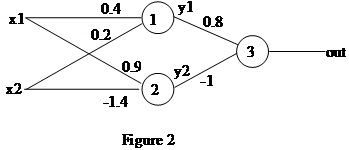Artificial Intelligence
1. A 4-input Neuron has weights (1,-1, 0, 0.5.Calculate the network output when the following input vectors are applied.

For calculation assume:
a. f(net) = unipolar binary
b. f(net) = bipolar binary
2. The network shown in figure 2 uses neurons with:
(a) Unipolar Binary;
(b) Bipolar Binary.

Calculate a table of responses to all four possible Boolean inputs.
Ex 3 (Portfolio). You are to complete the subsequent coronary disease production system :-
The Rules:
Rule 1:
IF X has a risk of heart attack
AND X has had a previous heart attack
THEN give X the drug Digitalis
Rule 2:
IF X has left quadratic pain
AND X has high blood pressure
THEN X has a risk of a heart attack
Rule 3:
IF X has raised intraocular pressure
THEN X has high blood pressure
Rule 4:
IF X has high blood pressure AND X is a heavy smoker
THEN X has a risk of a heart attack
Rule 5:
IF X is an asthmatic AND X has a risk of heart attack
AND X has had a previous heart attack THEN
Give X the drug Preminol-V (this is a fictional drug name!!)
The Facts:
A: Smith has raised intraocular pressure
B: Smith has had a previous heart attack
C: Smith has left quadratic pain
D: Smith is a heavy smoker
E: Jones is an asthmatic
F: Jones has raised intraocular pressure
G: Jones is a heavy smoker
________________________________________
%forward chaining Production system
:-op(800,fx,if). %set operators for if
:-op(700,xfx,then). %then rules
:-op(300,xfy,or).
:-op(200,xfy,and).
%dynamic(....) allows predicate inside brackets fact to be asserted and retracted,
% here were are making fact (/1 means fact has 1 argument) dynamic so we can add and
% take facts from working memory.
:-dynamic(fact/1).
fact(has(smith,raisedIntraocularPressure)). %list of facts
...
forward:-
new_fact(P),
!,
write('New fact '), write(P),nl,
asserta(fact(P)), %adds a fact to working memory
forward
;
write('no more facts').
new_fact(Action):-
if Condition then Action,
not(fact(Action)),
composedFact(Condition).
composedFact(Cond):-
fact(Cond).
composedFact(C1 and C2):-
composedFact(C1),
composedFact(C2).
composedFact(C1 or C2):-
composedFact(C1)
;
composedFact(C2).
if has(Person,riskOfHeartAttack) and has(Person,previousHeartAttack) %list of rules
then need(Person,digitalis).
...
not(X):-
X,!,fail;true.
________________________________________
Once you have added all the relevant facts and rules to the code (ensuring you have capital letters in the correct places!!) - start the ball rolling by the query '?- forward.' - its also worth tracing the execution of the code using 'trace' to follow the firing of the rules.
Ensure you understand how the if .. then .. definitions work and the action of the assert command.
How does your production system decide which rule to fire next?
Does this differ from those covered in the lecture and the associated texts?
Can you think of any better methods for determining the order?
Ex 4 (Portfolio).
Improve your code so that the list of facts in the database can be printed to the screen. Similarly add a command to list all the rules in the database.